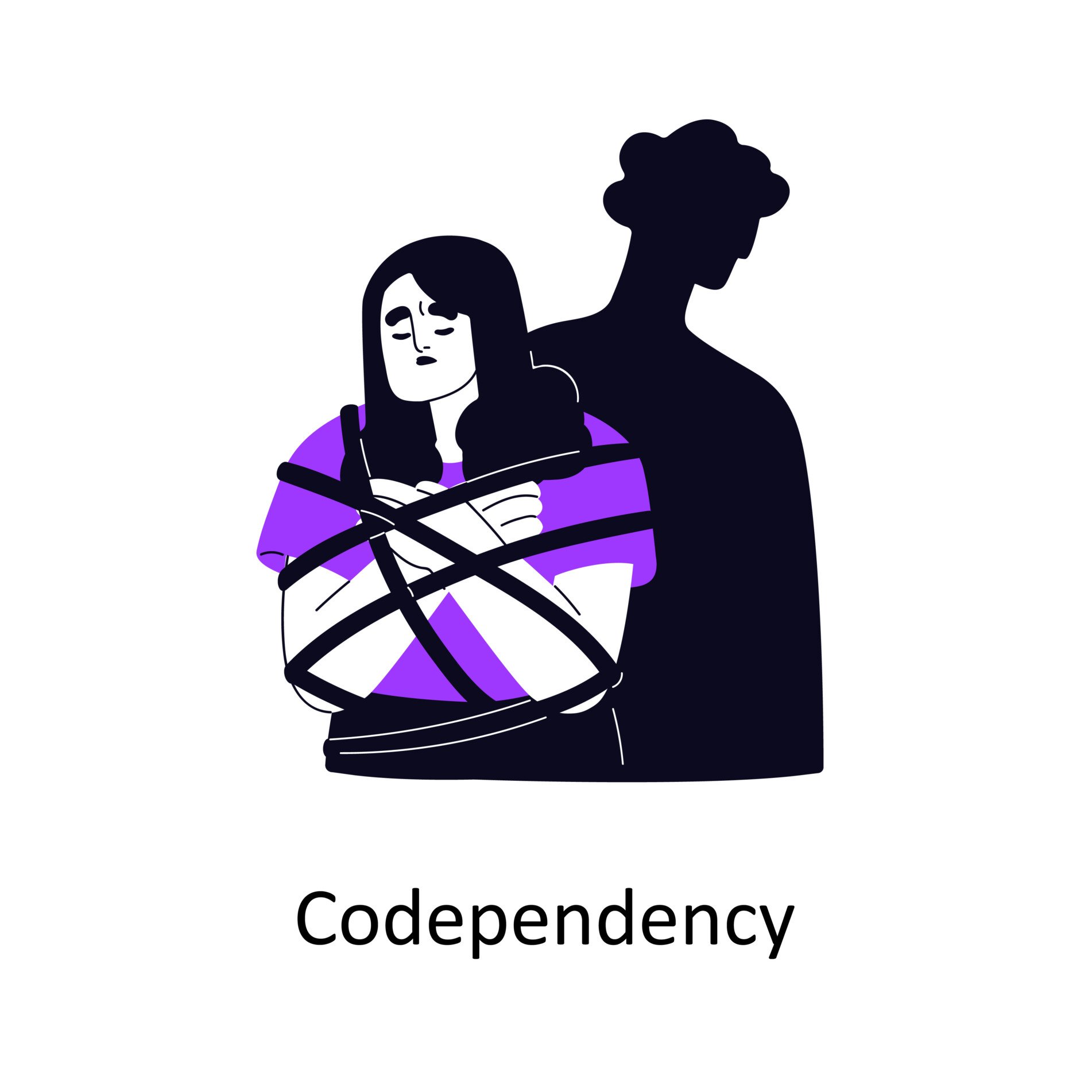Codependent relationships are generally considered unhealthy because they often involve a pattern of excessive emotional or psychological reliance on another individual. While such relationships may initially feel passionate and satisfying, they tend to turn dysfunctional and toxic rather quickly.
Healthy relationships involve a balance of giving and receiving support, with both partners maintaining their individual identities and respecting each other’s autonomy. In contrast, codependent relationships tend to be irrational and unstable, threatening the emotional and mental well-being of those involved.
Codependency tends to involve unhealthy dynamics, such as over-dependency, blurred boundaries, poor communication, emotional suppression, skewed power dynamics, confusing emotions, and the potential for abusive and manipulative behaviors.
In codependent dynamics, both partners often reinforce and enable each other’s unhealthy patterns, creating a cycle that can be difficult to break. This mutual dependency can lead to a lack of personal growth and can hinder the development of the identities within the relationship.

Here are several ways in which codependent relationships can negatively impact both members of a couple:
1. Definition of Self Through Others
Codependents have a strong tendency to define their own worth, identity, and happiness in relation to others. A codependent individual may measure their self-worth based on their ability to care for, please, or “save” another person.
A lack of a stable sense of self is a common characteristic of codependent individuals.
Codependent individuals may merge their identity with that of their partner, making it challenging to differentiate between their own needs, desires, and emotions and those of their partner.
They may find it difficult to make independent decisions as fear of upsetting their partner or making the “wrong” choice can paralyze their ability to take action.
Codependents often rely on external validation, particularly from their partner, to feel a sense of worth and identity. As such, their self-esteem becomes intertwined with how others perceive them.
Their desire to please means they put the needs, feelings, and opinions of others above their own, and they can become resentful when this is not reciprocated.
Without a strong sense of self, codependent individuals tend to become emotionally reactive, their emotions fluctuating based on external events or the moods of those around them.
A low self-esteem and an unstable sense of identity do not provide a healthy foundation for a relationship. Being in such a relationship will only serve to perpetuate these insecurities as the codependent individual becomes lost in the relationship and lives to please their partner.
2. Unhealthy Boundaries
Codependency can manifest in a relationship in which there is a lack of healthy boundaries. When healthy boundaries are lacking, the lines between individuals become blurred, leading to confusion and stress.
Codependent individuals may experience a high degree of enmeshment, where there is little distinction between their own feelings, thoughts, and needs and those of their partner. This can result in a loss of personal identity.
Additionally, in codependent relationships, individuals may find it challenging to say no or express their own needs and desires. They may prioritize their partner’s wants over their own, leading to a sense of self-neglect.
As noted above, codependent individuals tend to rely excessively on their partner for emotional support, making it difficult for both individuals to function independently and manage their emotions without the constant presence of the other.
Codependent couples may develop a shared identity, often centered around their relationship. This can make it challenging for individuals to pursue their own interests and maintain connections outside of the relationship.
3. Suppression of Needs and Emotions
Codependents often find it difficult to express their needs and feelings because they have a fundamental fear of rejection or abandonment.
The fear of being abandoned or rejected can lead codependent individuals to tolerate unhealthy behaviors, compromise their own values, or suppress their needs to avoid conflict and ensure the relationship’s continuation.
While it might seem counterintuitive, some individuals in codependent relationships may derive a sense of self-worth from their ability to sacrifice and suppress their own needs and feelings for the sake of their partner. This behavior is rooted in a belief system that places value on self-sacrifice as a measure of love and dedication.
Deep down, their underlying hope is that if they continue to give, it will eventually lead the other person to change and reciprocate. However, this tends to only end in disappointment and resentment.
Constantly sacrificing one’s own needs and feelings for others can lead to a neglect of personal well-being. Over time, this can result in emotional exhaustion, resentment, and a diminished sense of individual identity.
4. Perpetuates Dysfunction
Enabling is a key feature in codependent dynamics, where each partner supports or allows the other’s dysfunctional behavior to persist. This can manifest in various ways, including enabling addiction, poor mental health, procrastination, or abusive and controlling behaviors.
In codependent relationships, there is often a reciprocal dynamic where one partner’s dysfunctional behavior is enabled and reinforced by the other.
The enabling dynamic in codependent relationships often operates on a subconscious level, driven by unmet emotional needs and patterns established earlier in life.
The codependent individual may find fulfillment in feeling needed – this can create a cycle where they unconsciously support the other person’s dysfunction to maintain a sense of dependency.
5. Unbalanced Power Dynamics
A core feature of codependency is the need for control – both control of the self and the control of others.
Codependents often go to great lengths to meet the needs of others, believing that by doing so, they can control the dynamics of the relationship and ensure its stability. This need for control is often rooted in a fear of abandonment, a desire for external validation, or an attempt to manage anxiety and uncertainty.
In addition, codependent individuals often exert excessive control over their own emotions, thoughts, and behaviors. This might involve suppressing their own needs, desires, and opinions to maintain harmony in the relationship.
This need for control can lead to perfectionism, where the codependent individual strives to meet unrealistic standards to gain approval and acceptance.
In a healthy relationship, both parties are equal – their feelings and needs are equally important, and neither person tries to dominate the other. However, when the power dynamic is unbalanced, abuse, manipulation, and control are more likely to occur.
6. Poor Communication
Communication issues are a prevalent and significant challenge in codependent relationships.
Codependent individuals often have a hard time identifying and expressing their own feelings. This is usually a result of years of prioritizing the needs of others over their own or from a fear of conflict and confrontation.
Additionally, the fear of rejection or abandonment may prevent codependent individuals from expressing their true feelings. They may worry that their needs or emotions will not be accepted or that they will disrupt the perceived harmony of the relationship.
Codependent relationships often involve unhealthy communication patterns, such as passive-aggressiveness, avoidance, or a constant need for reassurance. These patterns can hinder effective and open communication and lead to misunderstandings and frustration.
Improving communication is essential for breaking the cycle of codependency and fostering healthier, more fulfilling relationships.
7. Increased Risk of Abuse
The traits associated with codependency, such as low self-esteem, people-pleasing tendencies, and a strong desire for compliance, can make individuals more vulnerable to entering or remaining in relationships with abusive partners.
Codependent individuals often have a diminished sense of self-worth, making them more susceptible to the manipulative tactics of abusive partners. The abuser may exploit this vulnerability to maintain control over the relationship.
In addition, the people-pleasing nature of codependents often involves a strong desire to keep the peace and avoid conflict. Abusive partners may take advantage of this by using threats or manipulation to maintain compliance and control.
It is not uncommon for codependents to enter into relationships with narcissistic individuals. Narcissists have a sense of entitlement and superiority – they are attracted to codependents because codependents tend to be highly compliant and willing to go to great lengths to meet the needs of their partner, even at the expense of their own well-being.
In all situations, abusive relationships can create a cycle of dependency, where the victim becomes increasingly reliant on the abuser. Codependent individuals, seeking validation and security, are likely to inadvertently become trapped in such a cycle.
8. Personal and Relational Stagnation
Communication challenges are a hallmark of codependent relationships, and these issues often manifest in two common patterns: avoidance and escalation.
In some cases, one or both partners will avoid discussing issues altogether. This avoidance can stem from a fear of conflict, a desire to maintain harmony at all costs, or a worry that addressing problems will lead to rejection or abandonment.
On the other hand, when issues are addressed, the communication may quickly escalate into arguments.
This can happen due to unmet emotional needs, frustration from long-standing issues, or a lack of effective communication skills.
These patterns often create a cycle of ineffective communication, where important issues are either left unspoken or are addressed in a way that hinders resolution and understanding.
9. Mental Health Issues
Codependency has been associated with various symptoms and behaviors related to mental health difficulties, such as depression and anxiety. It has also been linked to eating disorders and compulsive behaviors, such as OCD and addiction.
Codependency involves a pattern of prioritizing others’ needs over one’s own, leading to neglect of personal well-being. This can contribute to symptoms of depression and anxiety, as individuals may experience chronic stress, feelings of inadequacy, and an inability to address their own emotional needs.
Additionally, the need for external validation and coping mechanisms often associated with codependency can lead individuals to turn to substances or compulsive behaviors as a way to manage stress and emotions. This can contribute to the development or exacerbation of addiction and other compulsive behaviors.
10. Dependency
Codependency refers to an unhealthy and often unsustainable relationship dynamic where individuals become overly reliant on each other, to the point that their well-being is intertwined and dependent on the other person.
This can manifest in various ways, including a fear of being alone, an intense need for approval, and a pattern of prioritizing the needs of another person over their own.
The fear that one cannot live without the other can create a cycle of unhealthy dependence, inhibiting personal growth and contributing to a range of relationship challenges.
11. The Dysfunction Can Be Passed Down to Children
Codependency and its associated behaviors and beliefs can be passed down from one generation to the next. This can create a cycle where patterns of codependency are repeated in family dynamics.
In some cases, children will learn by observing the behaviors of their parents. If they witness codependent patterns in their parents’ relationship, they may internalize these behaviors as normal and replicate them in their own relationships.
I️n other cases, codependency may become normalized within the family, making it challenging for children to recognize these patterns as unhealthy. As a result, they may unconsciously perpetuate codependent dynamics in their own relationships.
The good news is that learned behaviors can be unlearned. Breaking the cycle of codependency often involves self-awareness, a commitment to change, and intentional efforts to develop healthier relationship patterns.
Julia Simkus edited this article.
Sources
Hughes-Hammer, C., Martsolf, D.S., Zeller, R.A. (1998). Depression and codependency in women. Archives of Psychiatric Nursing, 12(6), 326-334.
Meyer, D.F. (1997). Codependency as a mediator between stressful events and eating disorders. Journal of Clinical Psychology, 53(2), 107-16.
Rossiter, S.K. (2004). Narcissism and Codependency. Wright Institute Graduate School of Psychology Doctoral Thesis.
Worth, M. J. (1996). Codependency and psychopathology. Doctoral Thesis, University of Alberta.


